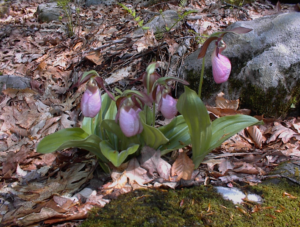Pink Lady’s Slipper
Cypripedium acaule

| Description: Pink lady’s slippers require bees for pollination. Bees are lured into the flower pouch through the front slit, attracted by the flower’s bright color and sweet scent. Once inside, the bees find no reward, and discover that they are trapped, with only one point of escape. Inside the pouch, there are hairs that lead to a pair of exit openings, one beneath each pollen mass. The bee must pass under the stigma, so if it bears any pollen from a visit to another flower, it will be deposited before picking up a fresh load on the way out. |
| Propagation: Seeds and root divisions, but the pink lady’s slipper interacts with a fungus in the soil from the Rhizoctonia genus. Generally, orchid seeds do not have food supplies inside them as other seeds do. Pink lady’s slipper seeds require threads of the fungus to break open the seed and attach them to it. The fungus will pass on food and nutrients to the pink lady’s slipper seed. When the lady’s slipper plant is older and producing most of its own nutrients, the fungus will extract nutrients from the orchid roots. This mutually beneficial relationship between the orchid and the fungus is known as “symbiosis” and is typical of almost all orchid species |
| Initial bloom (month and week): May W4 |
| Garden name: Shady Woodland Garden |
| Color of flower: Pink |
| Height: 12″ |
| Spread: 12″ |
| Family: Orchidaceae |
| Soil type: Acidic |
| Soil moisture: Dry |
| Light: Shade |
| Zone: 3-9 |